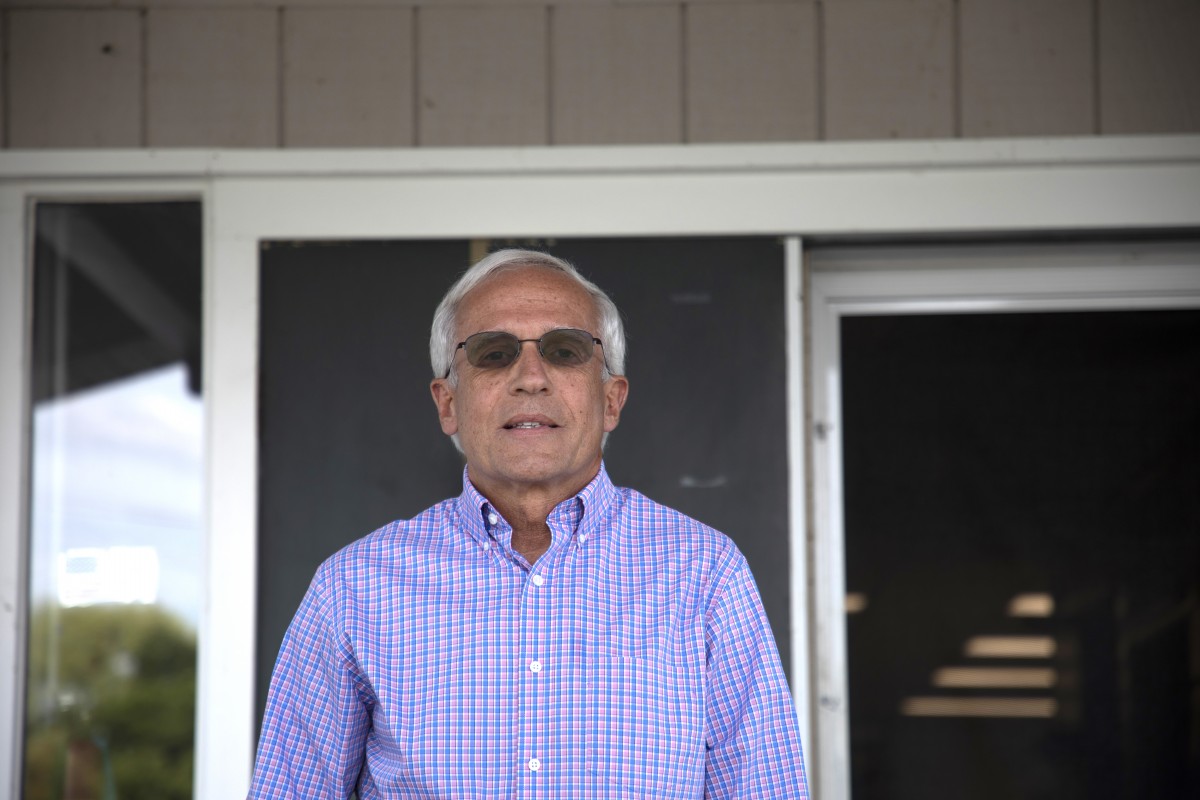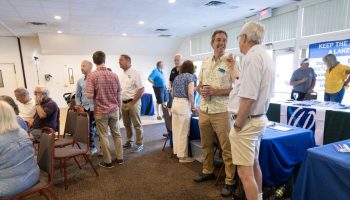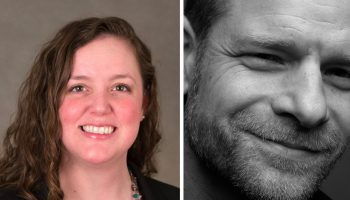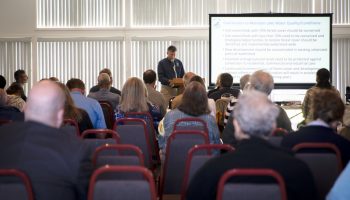As closely as does anyone in Chautauqua County, Pierre Chagnon personifies the answer to a question often asked of the county executive. The question is, “What are you doing about the lake?” Chagnon sits at the intersection of several lines of county, municipality, organizational and foundation efforts to try to keep Chautauqua Lake from further deteriorating.
He is in his third term as a member of the county legislature representing the town of Ellery, which includes the village of Bemus Point and the town of North Harmony, which sits roughly across the lake from Ellery and includes Stow and Asheville. Chagnon is the current board chair of the local Audubon Community Nature Center. Chagnon, whose nephew’s wife works in the Institution’s development office, has also just completed his first year as chair of the Chautauqua Lake and Watershed Management Alliance (commonly called the Alliance) Board of Directors, a grouping of local municipalities and nonprofit organizations formed in an effort to better coordinate regional efforts for the lake and to stimulate attempts to bring in more grant and public money from outside this immediate area.
Since its inception, the Alliance has suffered resentment from several lake-based organizations that have expressed concern that it will infringe on their autonomy and access to public and foundation funding. At the same time, however, the Alliance may be finding some traction as a potential referee and distributor of funding from multiple sources dedicated to improving the quality of the lake.
Chagnon spoke to the Daily on the patio of his home high on an eastern slope overlooking Chautauqua Lake.
Talk about your early career.
I was born and raised in the Driftwood area near Bemus Point, really not too far from where I live now. I attended Cornell University, got my B.S. in biology, with majors in physiology and anatomy. I tried but failed to gain admittance to (Cornell’s) New York State College of Veterinary Medicine and looked around for alternatives. In the end, I went to the business school at Cornell and got an M.B.A. I majored in finance.
After graduation, I went to work for a local firm called TRW Bearings Division. This was a legacy company started in Jamestown. It was a full-line bearings supplier, and I started with them as a financial analyst. I spent 31 years there. The company was soon sold to SKF, the largest bearings company in the world. We (reorganized) our part of this giant firm to become the largest aerospace bearings supplier in the world. I wound up as their director of operations.
I had a goal to retire just before I hit the age of 60 and just made it. After I did retire, I took six months off before saying yes to any opportunities. Then, Vince Horrigan asked me to consider running for his county legislature seat when he gave it up to run his race for county executive. I agreed and was elected in 2013. The district I represent, comprising the towns of Ellery and North Harmony, accounts for almost half of Chautauqua Lake’s shoreline. The lake was clearly going to be one of my top priorities. I got involved with lake issues and lake organizations.
What are the basics of the county legislature?
Well, after redistricting, there are 19 districts and legislators are elected for two-year terms. I was elected to Vince’s seat and have been re-elected twice.
What were the origins of the Alliance and your association with it?
I became first involved with the Chautauqua Lake Management Commission, which was set up as an advisory body to the legislature. They had existed for several years at that point and coordinated the production of a Chautauqua Lake Watershed Management Plan. That plan, issued in 2012, won awards. The commission intended to do an in-lake plan to complement its watershed plan, but wanted action on the watershed plan first. The legislature chose not to fund implementation of the watershed plan’s recommendations.
The commission concluded that it needed to evolve into an organization that could get its own authority to secure funding and take action itself. The commission met with state Sen. Cathy Young and state Rep. Andy Goodell. Young and Goodell assured us that there would be no support in Albany for empowering the commission to raise public funds. We looked elsewhere for the means to fund and implement the commission’s watershed recommendations.
We hit upon the Chagrin River Partnership, established along that river on the east side of Cleveland. That partnership started out as a 501-3(c) not-for-profit with the aim of securing grant funding for their watershed from outside the Cleveland area. They began with just a handful of municipalities and organizations, and after some time, they had some success in securing outside funding, which in turn stimulated participation by other local organizations. They got millions of outside dollars. This seemed to be a template that could work for us.
There were four of us from the county who basically set up the Alliance. Board members from the Chautauqua Lake Association and the Chautauqua Watershed Conservancy were part of this small group. We got some support from the local Sheldon Foundation to hire an attorney, got IRS certification as a 501-3(c) pretty quickly and created the organization, bylaws and charter. We formed our first interim board in 2014. We hired an executive director who helped with member recruitment.
Was the Alliance Vince Horrigan’s answer to the question, “What are you doing about the lake?”
Well, Vince was certainly supportive of the Alliance concept. He thought the Alliance could be a big part of the answer to that question. The county bed tax had been divided, with 3 percent to tourism and 2 percent to all county lakes and waterways. He liked the potential coordination aspect as well as the possibility to secure additional funding from outside the county.
What is the Alliance staffing profile now?
We have our executive director, one project manager and one part-time summer employee to help the director with grant writing.
Initially, we assumed our member organizations would bring us projects, and we would write up and submit the grant requests in the name of Chautauqua County, since we were not eligible as a nonprofit to submit the requests directly to the state, through a mechanism called the Consolidated Funding Application process. The CFA deadline is at the end of July, so because we began operations not longbefore that deadline in our first year, we had to initially piggyback on five project applications already mostly prepared. We submitted all five, and they all got funded. This was not the slow Chagrin River-style start we had envisioned. We brought our project manager on board to help implement the projects.
This is complicated.
It is. But part of our job with the Alliance is to assist in navigating the process. And the project manager may need to hire engineers and other contractors to assist our members in actually implementing projects they propose.
We did anticipate from the start that our members would be bringing to us lots of proposals. That did not happen. So we are becoming more active in encouraging our members to submit projects that can be submitted as grant requests. A stormwater management study for the town of Busti/village of Lakewood last year gave rise to a successful grant, and we have hired a consultant to help with project development. The result was six project proposals. Our director is writing up three for CFA funding this year.
Lake-based agencies and organizations might well resist imposition of the Alliance as an additional layer over their operations, and as an unwelcome derogation of their autonomy, authority, funding and visibility.
It’s hard to argue with that premise. This may have explained the lack of projects initially submitted to us. And I don’t think members’ concerns were unreasonable at all. They’re certainly understandable. We were asking them to trust us to work and get the process right. But our support was pretty strong across all the membership. We began with 37 members, including Chautauqua Institution and, at least initially, the Chautauqua Property Owners Association. The Institution’s Vice President of Campus Planning and Operations John Shedd attends our Alliance meetings and is an influential contributor.
The last two county executives have reminded residents repeatedly that the county does not own Chautauqua Lake. The state owns it and delegates to its Department of Environmental Conservation the authority to manage it.
Right. And the federal government has delegated to the Army Corps of Engineers some authorities over the lake also. The corps has control over the dam on the lake outlet (the Chadakoin River) in Jamestown because it is a flood control device, for example. So we have a body of water that is owned by the state and regulated by the state and by the federal government. Neither the county nor the towns and villages have any regulatory authority at all over the lake.
The Alliance has been in operation for over three years. What is its biggest achievement so far?
I’d identify two things. One is the success we have had with getting some grants funded. But the bigger one is the implementation of the idea of an alliance of lake-related organizations all pulling together and applying their collective weight to the applications we submit. The fact that an umbrella organization like the Alliance represents such a broad range of affiliates certainly strengthens our applications.
You have promoted development of a so-called tool to provide a kind of objective measuring instrument with which to assess and compare project proposals. It would offer a transparent standard that could establish which projects could be supported and submitted for funding.
This is a multicriteria program — an elaborate Excel spreadsheet, if you will — to apply weighted criteria to proposals. Scientific criteria are involved, but also the interests and priorities of the communities. In doing their research, the consultants we hired identified human health as by far the No. 1 concern of the communities. This was probably intuitively obvious. But it’s obviously also not insignificant. This and other data are already influencing our decisions.
We used the tool to help to determine which projects to support in 2018.
How did you select the firm that developed the tool?
We sent out a request for proposals, but most replies were from engineers and consultants who did not understand that our objective was to marry the science with community desires as key elements of our decisions. But one firm did get it, and we hired them. Both the consulting firm and the affiliated engineers, both based in Syracuse, had done this before in Cayuga County and Ithaca, New York, as one example. We have been pleased with the results.
We, on the Alliance, feel we have been able to deliver for the foundations and the county. Of our local foundations, a major lake supporter has been the Sheldon Foundation. When they saw our tool applied to sample project applications, they asked the Alliance to make decisions on allotting the money they had earmarked for the lake. We announced 2018 funding decisions on Sheldon Foundation grants at our June meeting.
The Alliance wants objectivity in decision-making and the ability to enforce its decisions.
Yes.
Do you feel you have that authority now, or are you just closer to your goal?
Well, we have secured funding from the state, from county government, from foundations and now pass-through funding from various sources. By pass-through, I mean the Alliance did not charge for its value added to proposals.
By granting to the Alliance this year the authority to parcel out its grants, the Sheldon Foundation did give us some real authority we could not previously exercise. Perhaps more foundations will follow their lead. But the ultimate authority, to manage the lake, is not likely going to be delegated to the Alliance in my lifetime.
Let’s say one of your member organizations disputes your funding allocation after applying the tool. How can they appeal your decision?
I’ll answer that in two ways. There is currently no appeal from foundation or county legislature funding decisions. However, now that we are using our analytical tool, we can tell an organization that appeals our decision to use the tool and score the project themselves and see if they are not convinced. We have a high degree of confidence in our methodology now. But ultimately, any appeal of our decisions would be heard by the same board that issued the decision. How much volunteer time do you donate to the Alliance? I’d say, on average, 20 hours a week.
We’ve talked about the pushback you’ve gotten from some organizations. Where does the appreciation come from?
Well, we have had good feedback from the foundations and from the county legislature. And from the towns and villages, to some degree, since they are also recipients of pressure to spend money on this or that project. I get some appreciation from members of the public.





